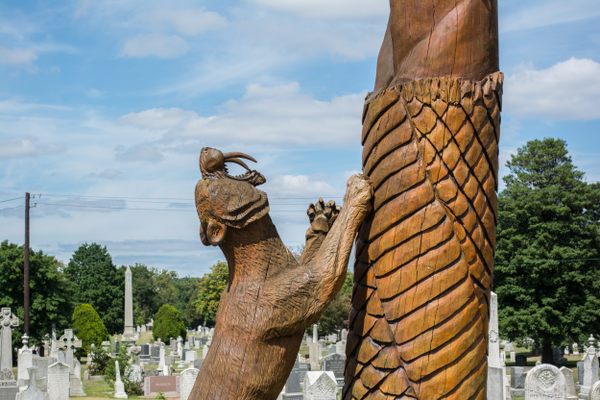AO Edited
Ruins of the McMillan Sand Filtration Site
An Industrial Revolution-era public work that purified water using nothing but sand.
Typhoid epidemics regularly swept across Washington at the turn of the century as the population increased and industrial pollution worsened. A chief culprit was the city water supply. The unfiltered Washington Aqueduct carried a stream laced with bacteria and a notorious amount of Potomac mud, described by a Washington Post reporter as a “Seal-brown mixture of water and real estate.”
Shortly after the new city reservoir was completed at Howard University, Congress authorized funds for an adjacent filtration site to address the public health situation. The facility relied entirely on sand to clean the water; at the time, this method scaled better and was more cost effective than using chemicals.
“Raw water” came in from the reservoir next door and slowly percolated through the sand in 25 vaulted underground cells before making its way out into District taps. The 4-foot lining of sand actually did a remarkable job at removing bacteria and sediment from the water.
According to a historic preservation report, the sand was brought in from Laurel, Maryland on the B&O Railroad and “went through an extensive preparation process to meet specifications for cleanliness, removing all traces of clay and other undesirable particles.”
Enormous quantities of fresh sand were stored aboveground in parallel rows of stubby concrete silos. Engineers could shovel it out when necessary and drop it down into the cells through 2,100 manholes that are visible in satellite imagery.
Improvements like the Washington Aqueduct and the McMillan Sand Filtration Site came to D.C. as part of the City Beautiful movement funded in large part by the Federal Government. The site is named after Senator James McMillan and propelled by support by President William Howard Taft, Congress and the Government set out to ensure the city and officlals themselves had clean water to drink.
At the time there was a different, more positive image of Washington’s water supply as a Public Work, and not merely a piece of infrastructure. As such, the nation’s foremost landscape architect was called in to devise a plan to pretty up the filtration site.
Frederick Law Olmsted Jr. designed a public park at the adjacent reservoir on the west side of 1st ST NW that became an important community gathering place for District residents. For a time, it was a popular destination for picnics, outdoor activities, or a quiet stroll away from the bustle of city life. Unfortunately, the park was fenced off for security reasons during World War II. It was promised to be reopened, but after African American soldiers came home and began to move into the area, Congress at that time chose not to reopen it.
This park extended as open green space across several parcels including above the sand filtration site. Despite believing, “perhaps inexpedient to admit the public to use the plain even upon a fenced path,” Olmsted created a pathway that surrounded and overlooked the sand filtration site. Despite the temptations to use the open plains most people chose not to venture out among the 2,100 manholes across the 20-acres with open vistas in all directions although there are images showing defacto use as baseball fields and like-recreational activities (Records indicate that between three and four acres of manholes would be open at any given time to provide light and air to workers that were cleaning the sand in the filter beds below.)
Olmsted’s plantings and perimeter pathway around the sand filtration site were designed to complement the “interesting and remarkable” appearance of the sand storage towers, the walls of which he covered in ivy.
D.C. city government purchased the McMillan Sand Filtration Site after it closed in 1986, but the site was sadly neglected by city officials despite historic protection requirements. It is a fantastic opportunity for preservation and a redevelopment project similar to New York’s High Line.
Today all 25 acres sit behind a chain-link fence. The 20 one-acre underground cement water cisterns are a magical mystical place despite the city’s neglect. There is a neighborhood movement to restore the underground and make it a public space, but its future is uncertain since the city has considered many other development plans for the site.
Updated July 2023: Unfortunately, the site is now currently under construction and this historical site is being demolished.
Know Before You Go
The sand filters have been closed to the public for some time. If a person were to gain access to the site they should remain vigilant. Dangers of falling through rotting/rusting manhole covers or into large pits are only a few risks that a person would be taking. Occasionally the property has been opened to the public for limited tours but not with any regularity. The site should be opened for safe viewing as the magnificence of the historic assets are second to none in the District of Columbia. SaveMcMillan.org/videos
Community Contributors
Added by
Edited by
Plan Your Trip
The Atlas Obscura Podcast is Back!



































Follow us on Twitter to get the latest on the world's hidden wonders.
Like us on Facebook to get the latest on the world's hidden wonders.
Follow us on Twitter Like us on Facebook